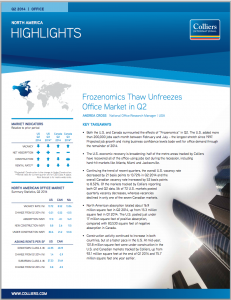 Colliers today released its mid-year report profiling activity in North American office markets. The results are mostly bullish:
Colliers today released its mid-year report profiling activity in North American office markets. The results are mostly bullish:
Following the negative weather impact on most economic metrics earlier in the year, the U.S. economy rebounded well in subsequent months, adding more than 200,000 jobs per month between February and July and registering real GDP growth of 4.2% in Q2. Increased hiring and rising business confidence bode well for the office market during the remainder of 2014.
The economic and office market recoveries are broadening to include more markets, including many of those hit particularly hard by the housing bust and financial crisis (e.g. Las Vegas, Orange County, Miami). Half of the U.S. metro areas tracked by Colliers have recovered all of the office-using jobs lost during the recession, and more than three-quarters of the North American office markets posted positive absorption in both Q2 2014 and year-to-date 2014.
Continuing the trend of recent quarters, the North American vacancy rate decreased modestly, by 15 basis points to 13.36% in Q2 2014, and we anticipate a similar trend during the remainder of the year. Once again, the U.S. vacancy rate decreased, by 21 basis points to 13.72%, and the Canadian vacancy rate increased, by 52 basis points to 8.52%. New supply is contributing to the rise in Canadian vacancies, although the overall vacancy rate remains below the 10% level considered indicative of a balanced market.
North American absorption totaled 16.9 MSF in Q2 2014 (17.0 MSF in the US, -83,530 sq. ft. in Canada). In the U.S., the four-quarter trailing quarterly average of more than 17.6 MSF of absorption in Q2 2014 was the highest level during the current recovery. The leading markets in Q2 2014 were Houston, San Francisco, Downtown Manhattan, Orange County, Midtown Manhattan, Atlanta, Dallas, Seattle/Puget Sound, Chicago and Kansas City.
Construction activity continues to trend upward, with 101.8 MSF under construction at mid-year 2014, up from 88.2 MSF at year-end 2013 and 75.7 MSF at mid-year 2013. Oversupply is generally not yet a concern in the U.S., with development activity concentrated primarily in the strongest markets and submarkets. The top markets for construction under way at mid-year 2014 were Houston, Toronto, Calgary, Washington, DC, Dallas, San Jose/Silicon Valley, San Francisco, Seattle/Puget Sound, Boston and Midtown South Manhattan.
North American office investment increased by 25% year-over-year in H1 2014 to $52.9 billion. Interest rates are expected to rise with the end of the Fed’s QE3 bond-buying program in October 2014 and likely rate hikes in 2015. Nonetheless, spreads between the 10-year Treasury and cap rates for suburban properties and secondary and tertiary markets generally remain wide, which, coupled with improving economic and office market conditions in these areas, should attract a greater amount of investor interest in the coming quarters. The relative stability and transparency of the North American real estate markets should continue to attract foreign investors to gateway cities and, increasingly, secondary markets in search of higher yields and less competition.
To download the full report, click here.
